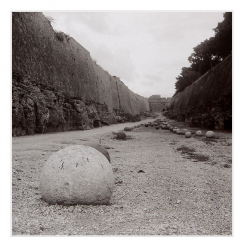-
Thank You For Visiting... Please Click Here and sign up to contribute and reply to posts and download the resources.
You are using an out of date browser. It may not display this or other websites correctly.
You should upgrade or use an alternative browser.
You should upgrade or use an alternative browser.
Height of the camera from the ground .
- Thread starter Camerashy
- Start date
- Joined
- Dec 19, 2017
- Messages
- 3,167
That depends on how much importance the foreground is to the image, you go lower to emphasise it and use more front/rear tilt.
If the foreground is unimportant, I tend to place the camera around maybe 60-66 inches from the ground.
Ian
If the foreground is unimportant, I tend to place the camera around maybe 60-66 inches from the ground.
Ian
Last edited:
Surely, camera height would be decided by the composition, not by optical geometry? Would not the priority be to place the lens where aesthetics demanded and apply movements afterwards as required?
It’s true that if something is very close in the foreground, then more extreme movement may be needed. Moving the camera away, which could be either either upwards or backwards, will alleviate this. This confirms your supposition.
Much will depend on what else is in the frame. If you are photographing a flat plane, a picture of a bowling green, perhaps, you should be able to get good focus from any height. Clearly the perspective would change as the height changed. If there’s a person in the picture, that would complicate matters. The tilt used for the grassy surface would give them sharp shoes and a fuzzy head. You might be making a comment on bowls players of course, but that’s another matter.
For a very complete discussion of camera movements, see Harold Merklinger, available as a free PDF download. He explains much more than I ever wanted to know.
It’s true that if something is very close in the foreground, then more extreme movement may be needed. Moving the camera away, which could be either either upwards or backwards, will alleviate this. This confirms your supposition.
Much will depend on what else is in the frame. If you are photographing a flat plane, a picture of a bowling green, perhaps, you should be able to get good focus from any height. Clearly the perspective would change as the height changed. If there’s a person in the picture, that would complicate matters. The tilt used for the grassy surface would give them sharp shoes and a fuzzy head. You might be making a comment on bowls players of course, but that’s another matter.
For a very complete discussion of camera movements, see Harold Merklinger, available as a free PDF download. He explains much more than I ever wanted to know.
Last edited:
- Joined
- Dec 19, 2017
- Messages
- 3,167
In this image the camera is around 12" above the front line of stones, as it was with a 75mm lens at f22 I had plenty of DOF.

It's the arena at Aphrodisius, where the Greeks held games every 4 years, we think of the Olympics but the ancient Greeks held games every year rotating between 4 different sites. This was a 617 camera with no movements,
Another shot maybe 3ft or lower
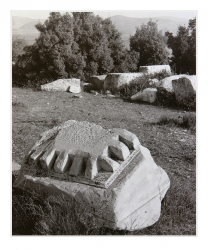
Using a low view point for emphasis, sometime you want the background to drift out of focus. Ruins of Athena temple, Notion
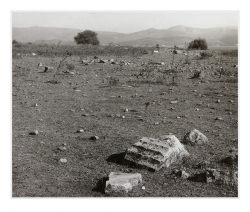
Another low view point, deliberately to emphasise the desolation. This is the ruins of the ancient city of Notion, with an early grid system of streets, which can still be seen from the air.
So you play with camera height as David says as part of composition,
Ian

It's the arena at Aphrodisius, where the Greeks held games every 4 years, we think of the Olympics but the ancient Greeks held games every year rotating between 4 different sites. This was a 617 camera with no movements,
Another shot maybe 3ft or lower

Using a low view point for emphasis, sometime you want the background to drift out of focus. Ruins of Athena temple, Notion

Another low view point, deliberately to emphasise the desolation. This is the ruins of the ancient city of Notion, with an early grid system of streets, which can still be seen from the air.
So you play with camera height as David says as part of composition,
Ian
Last edited:
- Joined
- Aug 6, 2016
- Messages
- 1,687
Do you ever move the back standart to change the size of foreground objects
- Joined
- Dec 19, 2017
- Messages
- 3,167
That happens when you shoot closer and lower to foreground objects anyway, as in the first image with a 75mm Super Angulon on my 617 camera.
There would have been quite a bit of front tilt on the second image, but the back would have been vertical and some rise to avoid losing the sky and mountains.
I was using this Crown Graphic at the time in Turkey, so there's no rear movements and only limited front tilt, enough for the second shot (above), but insufficient for some of the images I wanted to make. I found a cheap a Super Graphic which has more front tilt.
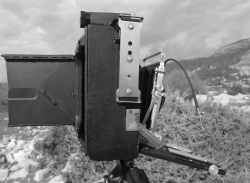
This was the camera set up at about 60" for the shot below, CZJ 150mm f4.5 T Tessar @ f22
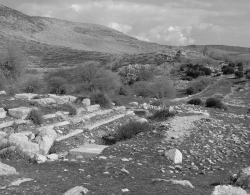
If you really want to exaggerate the size of something in the foreground then you shoot very close and low with a wide angle lens.
Ian
There would have been quite a bit of front tilt on the second image, but the back would have been vertical and some rise to avoid losing the sky and mountains.
I was using this Crown Graphic at the time in Turkey, so there's no rear movements and only limited front tilt, enough for the second shot (above), but insufficient for some of the images I wanted to make. I found a cheap a Super Graphic which has more front tilt.

This was the camera set up at about 60" for the shot below, CZJ 150mm f4.5 T Tessar @ f22

If you really want to exaggerate the size of something in the foreground then you shoot very close and low with a wide angle lens.
Ian
- Joined
- Dec 19, 2017
- Messages
- 3,167
Do you ever move the back standart to change the size of foreground objects
I've posted this image before, it's a good example of a low view point to exaggerate foreground.
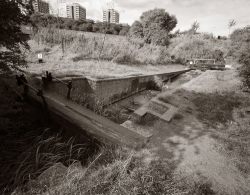
As it was a 65mm Super Angulon a tiny bit of tilt goes a lot further. It's a good example of not to build a relatively shallow colliery next to a flight of locks, the flats are about 1/4 of a mile away.
Ian
- Joined
- Aug 6, 2016
- Messages
- 1,687
Ive notoced that these examples are using a fairly wide lens. How much of this effect would you expect to see on say a 150mm lens
Rear tilt (and swing) will alter the geometry of the image. See the flats, just visible at the top of Ian’s first image. If the geometry is really important, then the back has to be vertical.
More generally, it has to be parallel to the object you want to be rendered correctly. In this case, the flats are of peripheral interest, so it doesn’t really matter. I’m pretty sure that Ian could have dealt with this if he’d thought it necessary.
In natural landscapes, where there are few verticals, tilting (or swinging) the back causes nearby objects to appear bigger, or to “loom”. It’s one of the creative resources of LF.
A corollary is that using the opposite movement will make a foreground object seem to shrink - another creative opportunity.
It does seem to be true that as focal length gets smaller, all the other dimensions associated with it shrink too. Apparent depth of field increases, but that’s another matter.
The greatest determinant of perspective will always be the position of the lens relative to the subject.
More generally, it has to be parallel to the object you want to be rendered correctly. In this case, the flats are of peripheral interest, so it doesn’t really matter. I’m pretty sure that Ian could have dealt with this if he’d thought it necessary.
In natural landscapes, where there are few verticals, tilting (or swinging) the back causes nearby objects to appear bigger, or to “loom”. It’s one of the creative resources of LF.
A corollary is that using the opposite movement will make a foreground object seem to shrink - another creative opportunity.
It does seem to be true that as focal length gets smaller, all the other dimensions associated with it shrink too. Apparent depth of field increases, but that’s another matter.
The greatest determinant of perspective will always be the position of the lens relative to the subject.
- Joined
- Aug 6, 2016
- Messages
- 1,687
I have a YashicaMat but it doesnt say 24 on it and to be honest using it low to to the ground is not something I have done but this photograph of Rhodos Castle is nice. I like the perspective and also the depth of field.
- Joined
- Dec 19, 2017
- Messages
- 3,167
More generally, it has to be parallel to the object you want to be rendered correctly. In this case, the flats are of peripheral interest, so it doesn’t really matter. I’m pretty sure that Ian could have dealt with this if he’d thought it necessary.
It's quite an old shot, and a very awkward spot to photograph and get the whole of the lock in the image. The 65mm f8 Super Angulon barely covers 5x4 and I have to tilt the both the front and rear standards back, and use rise, otherwise the front of the focus bed is in the image, In practice it's quick and simple, but with no options for movements, other than slight tilt, because of the image circle, I had to point the camera so the back wasn't vertical.
If there was room at the edges of the image it would be possible to correct during printing, but you'd crop critical detail. It's one of those compromises we make in the field, and I wanted the flats in the image. Ultimately the image works because of the distorted perspective of the twisted sunken lock.
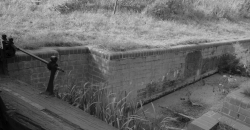
When the Richardson twins redeveloped the Round Oak Steel Works site as the Merry Hill Shopping Centre, they breeched the canal which went through the site.
British Waterways made them do some remedial/restoration work on this the original top lock of the old flight, hence the relatively modern brickwork.
Ian
- Joined
- Aug 6, 2016
- Messages
- 1,687
@Ian Grant I dont think you use Adobe LightRoom so I was wondering what system you use to catalog your scans as you appear to keep good detailed information about each scan
- Joined
- Dec 19, 2017
- Messages
- 3,167
I use a system called Hap Hazard, I can sell it to you if you like . . . . . . . I do catalogue my negatives. I did catalogue my digital scans in a free Access Photocat database, that i contributed to, Then Microsoft upgraded Access using a different version of Basic. I had to rewrite our Labs database, it took in Customer data, we inputted results, and generated the monthly invoices.
I've never bought a Microsoft product again, except the OS on a computer, and won't
As I shoot bodies of work the images are stored in relevant folders high res and fimished, with _md or _sm at the end to designate the size, but that's changing,
Ian
I've never bought a Microsoft product again, except the OS on a computer, and won't
As I shoot bodies of work the images are stored in relevant folders high res and fimished, with _md or _sm at the end to designate the size, but that's changing,
Ian
- Joined
- Aug 15, 2016
- Messages
- 109
I've posted this image before, it's a good example of a low view point to exaggerate foreground.
View attachment 3404
As it was a 65mm Super Angulon a tiny bit of tilt goes a lot further. It's a good example of not to build a relatively shallow colliery next to a flight of locks, the flats are about 1/4 of a mile away.
Ian
Is that Brierley Hill flats in the background? Just saw your next post and it is...
Returning to the original question, it might be helpful to visualise the Hinge Point.
When the lens and film standard are parallel, their planes and the plane of sharp focus meet at infinity That is, they don't meet at all.
When either front or back is moved, the focal plane tilts and all three now meet each other at a point.
(Strictly speaking, they intersect at a line, but we are so accustomed to seeing this ilustrated by two-dimensional drawings that we call it a point.)
These planes move like the pages of a book (with the spine as a hinge) as it's opened and closed and it's relatively easy to stand beside the camera and reconstuct the diagram in your head. This will give some idea of where the plane of focus will fall and what you might do to change it. If you want to go further, you can use something like garden canes to define where everything falls.
All of this applies to swing too. You might need to get the whole of a receding wall in focus, for example. The same rules would apply and you could exaggerate or diminish the Near by swinging the film plane. The same would apply again if you were photographing a long border in a garden.
I came across a Victorian example of how lens swing has another useful function. In photographing a procession or parade, we'd usually think of stopping down for greater DoF. Stopping down would need a longer shutter speed and the procession would have moved on by the time the shutter closed. Using front swing to put the plane of focus along the procession meant being able to use the lens wide open with a much higher shutter speed.
When the lens and film standard are parallel, their planes and the plane of sharp focus meet at infinity That is, they don't meet at all.
When either front or back is moved, the focal plane tilts and all three now meet each other at a point.
(Strictly speaking, they intersect at a line, but we are so accustomed to seeing this ilustrated by two-dimensional drawings that we call it a point.)
These planes move like the pages of a book (with the spine as a hinge) as it's opened and closed and it's relatively easy to stand beside the camera and reconstuct the diagram in your head. This will give some idea of where the plane of focus will fall and what you might do to change it. If you want to go further, you can use something like garden canes to define where everything falls.
All of this applies to swing too. You might need to get the whole of a receding wall in focus, for example. The same rules would apply and you could exaggerate or diminish the Near by swinging the film plane. The same would apply again if you were photographing a long border in a garden.
I came across a Victorian example of how lens swing has another useful function. In photographing a procession or parade, we'd usually think of stopping down for greater DoF. Stopping down would need a longer shutter speed and the procession would have moved on by the time the shutter closed. Using front swing to put the plane of focus along the procession meant being able to use the lens wide open with a much higher shutter speed.
- Joined
- Aug 6, 2016
- Messages
- 1,687
As I shoot bodies of work the images are stored in relevant folders high res
Are the bodies of work for you or commisioned. If they are for you, what makes you decide what is going to be a body of work or do you simply look back at previous photographs and pull them into a folder of relevamce which then becomes the body of work
- Joined
- Sep 25, 2017
- Messages
- 345
Can I recommend the works of Harold Merklinger?
Here's a link to one of his PDF files http://www.trenholm.org/hmmerk/FVCADNDM.pdf which might prove useful
And here's a ZIP file with the movies of the Scheimpflug principle in action (update from an old and now unreadable format). Open them in a player and then slide the playing cursor forwards and backwards to see what changes.
Here's a link to one of his PDF files http://www.trenholm.org/hmmerk/FVCADNDM.pdf which might prove useful
And here's a ZIP file with the movies of the Scheimpflug principle in action (update from an old and now unreadable format). Open them in a player and then slide the playing cursor forwards and backwards to see what changes.
Attachments
Last edited:


